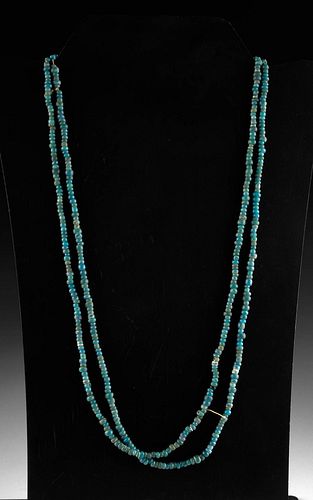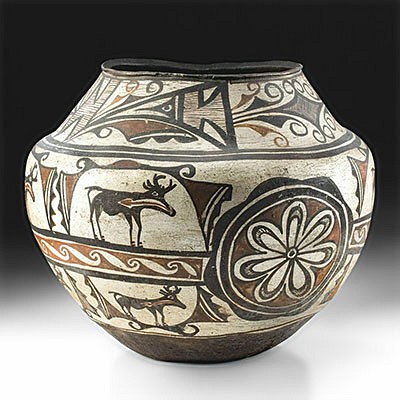19th C. Native American Atasi Blue Glass Trade Beads
Lot 25a
About Seller
Artemis Fine Arts
686 S Taylor Ave, Ste 106
Louisville, CO 80027
United States
Selling antiquities, ancient and ethnographic art online since 1993, Artemis Gallery specializes in Classical Antiquities (Egyptian, Greek, Roman, Near Eastern), Asian, Pre-Columbian, African / Tribal / Oceanographic art. Our extensive inventory includes pottery, stone, metal, wood, glass and textil...Read more
Categories
Estimate:
$800 - $1,200
Absentee vs Live bid
Two ways to bid:
- Leave a max absentee bid and the platform will bid on your behalf up to your maximum bid during the live auction.
- Bid live during the auction and your bids will be submitted real-time to the auctioneer.
Bid Increments
| Price | Bid Increment |
|---|---|
| $0 | $25 |
| $300 | $50 |
| $1,000 | $100 |
| $2,000 | $250 |
| $5,000 | $500 |
| $10,000 | $1,000 |
| $20,000 | $2,500 |
| $50,000 | $5,000 |
| $100,000 | $10,000 |
| $200,000 | $20,000 |
About Auction
By Artemis Fine Arts
Nov 18, 2021
Set Reminder
2021-11-18 10:00:00
2021-11-18 10:00:00
America/New_York
Bidsquare
Bidsquare : Art & Artifacts of North America
https://www.bidsquare.com/auctions/artemis-gallery/art-artifacts-of-north-america-7894
Join us for a special auction not to be missed! Collectible Native American art from antiquity to mid-20th century, Spanish Colonial, Latin American, Pre-Columbian, fine & folk art, American frontier items, fossils, and much more! Artemis Fine Arts info@artemisgallery.com
Join us for a special auction not to be missed! Collectible Native American art from antiquity to mid-20th century, Spanish Colonial, Latin American, Pre-Columbian, fine & folk art, American frontier items, fossils, and much more! Artemis Fine Arts info@artemisgallery.com
- Lot Description
Native American, Southern United States, Alabama, Elmore County, Muscogee / Creek tribe, Atasi people, ca. 19th century CE. A lovely collection of glass trade beads made by Europeans to trade with the Native American tribes in the Southern part of the United States. This strand is comprised of over 200 blue glass seed beads that are strung on a modern thread, enough to wear wrapped as two strands! These beads are perfect to restring as a wearable necklace to use as accents or on their own! All were collected from a village site with documented Spanish contact that existed from the 1500s through 1814. The village was destroyed in April 1814 during the Creek uprisings but was later reoccupied, and these beads likely date to one of the post 1814 occupations. Size (strand doubled): 48" L (121.9 cm); (average bead): 0.13" Diameter (0.3 cm)
Atasi - also spelled Otasse, Atusse, Auttossee - were a branch of the Creek / Muscogee tribes along the Tallapoosa River from about 1560 to 1813 CE and moved periodically due to soil and river conditions. On November 29th, 1813, the Atasi people joined in the Creek War (Red Stick War) and in 1814 they refused to sign the Treaty of Fort Jackson, and many migrated to Florida and joined the Seminole Nation. After the First Seminole War in 1818, Creek and Seminole peoples, displaced by war and American settlers, returned to their homelands in Alabama. Between the early 1800s and the 1832 Treaty of Cusseta, the Creek nation had lost most of their land to white settlers through laws, pressures, violence, and treaties. The Treaty of Cusseta ceded all of Creek land east of the Mississippi to the United States, with meager land claims granted to individual Creeks. Conflicts between white settlers and remaining Creek landowners intensified, and in 1835 the US government forcibly relocated most of the remaining Creeks to the Indian Territory in Oklahoma. The Atasi sites along the Tallapoosa and Saguache rivers were demolished by quarries and other modern developments. These beads are likely possessions that were left behind during the sad Trail of Tears march.
Provenance: ex-private Ashland, Ohio, USA collection; ex-Peter Brandon collection, Montgomery, Alabama, USA
All items legal to buy/sell under U.S. Statute covering cultural patrimony Code 2600, CHAPTER 14, and are guaranteed to be as described or your money back.
A Certificate of Authenticity will accompany all winning bids.
PLEASE NOTE: Due to recent increases of shipments being seized by Australian & German customs (even for items with pre-UNESCO provenance), we will no longer ship most antiquities and ancient Chinese art to Australia & Germany. For categories of items that are acceptable to ship to Australia or Germany, please contact us directly or work with your local customs brokerage firm.
Display stands not described as included/custom in the item description are for photography purposes only and will not be included with the item upon shipping.
#167510Nicks and abrasions to beads. Light mineral deposits. All are strung on a thread, and we recommend restringing these beads to make them more secure if you intend to wear as a necklace.Condition
- Shipping Info
-
All shipping is handled in-house for your convenience. Your invoice from Artemis Gallery will include shipping calculation instructions. If in doubt, please inquire BEFORE bidding for estimated shipping costs for individual items.
-
- Buyer's Premium



 EUR
EUR CAD
CAD AUD
AUD GBP
GBP MXN
MXN HKD
HKD CNY
CNY MYR
MYR SEK
SEK SGD
SGD CHF
CHF THB
THB













